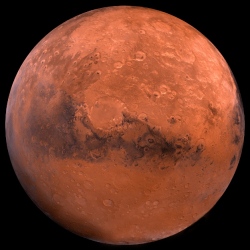
Mars was hit by an asteroid so large that it melted nearly half of the planet’s surface. Researchers came to this conclusion while studying a strange feature known as the Martian hemispheric dichotomy, a dramatic drop in surface elevation and crustal thickness that occurs near Mars’ equator.
In the northern hemisphere the land’s elevation is on average about 5.5 kilometers lower and the crust is around 26 kilometers thinner. The dichotomy was discovered in the early 1970s when NASA’s Mariner 9 probe made the first detailed map of the Martian surface. The feature has perplexed astronomers ever since.
Previous studies hinted that the dichotomy was formed by a glancing asteroid strike near the Martian north pole. But the new work, published in Geophysical Research Letters in December, suggests that a far more violent impact, at the opposite end of the planet, may have been the actual cause.
In the study astronomers at the Swiss Federal Institute of Technology (E.T.H. Zurich) used an advanced 3-D computer model to simulate the effect of an asteroid impact on Mars 4.5 billion years ago, when experts think the dichotomy formed. They tested a rival hypothesis for its origin, that it had been formed by an impact at Mars’s south pole.
When the team simulated a collision with an asteroid about 4,000 kilometers across (slightly larger than Earth’s moon) they found that it caused the crust of the “virtual” Mars to reform into two distinct zones: a thicker one in the southern hemisphere and a thinner one in the north, similar to what we see on the real planet. What’s more, the predicted thicknesses of the two crustal segments matched the real values observed on Mars almost exactly.
Taken together these predictions provide compelling evidence that a south polar impact was the cause of the dichotomy. “This study advances an alternate impact origin for the Martian dichotomy,” says Craig Agnor, an astronomer at Queen Mary, University of London, who was not involved in the work.
The simulation predicted that the impact would have generated so much heat that large swathes of Mars’s crust would have melted, forming a “magma ocean” across most of the planet’s southern hemisphere. It also predicted that, as the molten rock subsequently cooled and solidified, it would leave a thicker, higher-elevation crust over part of that hemisphere.
These findings do not conclusively solve the mystery of the dichotomy’s origin. The Swiss team’s model is not perfect; for example, it cannot explain the dichotomy’s exact size. And in any case, it is not possible to prove a hypothesis using only a computer model. But there is another reason to think that the southern impact hypothesis might be right: It sheds light on another oddity of Mars’s surface, the locations of its volcanoes.
